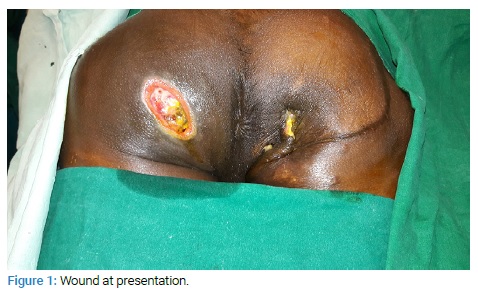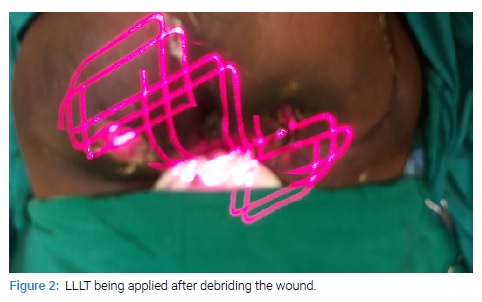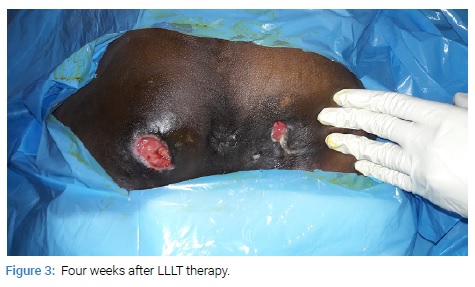Abstract
The pressure ulcer also called bed sore or decubitus ulcer is one of the complications seen in bedridden patients. Management of these ulcers is often challenging. But there is no well-established method that accelerates the wound healing rate. In this article we would highlight the role of laser therapy in wound bed preparation in the case of a pressure ulcer.
Introduction
Pressure ulcers are commonly seen in critically-ill patients. Despite an increased number of therapies available for managing pressure ulcers, none has demonstrated any clear benefit over the others and pressure ulcer treatment remains difficult and time-consuming. Surgery may be required to cover the raw area but should be used as the last resort, as recurrence is often the rule. Also, the general condition of the patients who acquires the pressure ulcer often renders them unfit for reconstruction surgery. For these reasons, pressure ulcers are mostly managed by conservative treatment. Various local wound therapies have been advocated for use in this difficult to treat the condition. Many clinical studies have reported the benefits of LLLT on tissue healing, but others have shown no effect. In this article, we share our experience of using LLLT in the case of a pressure ulcer.
Methodology
This is a case report of the use of LLLT in a case of pressure ulcers. This study was conducted in a tertiary care hospital in 2019 (Figure 1).

The patient was 30 year male with post-spinal cord injury pressure ulcers on the bilateral ischial region for 3 months. The patient was thoroughly investigated. Wound tissue culture was sent and appropriate antibiotic therapy was given. Regular cleaning and dressing were done, but the wound was not showing any good sign of healing. To hasten the wound bed preparation decision was made to give a trial of LLLT. After debridement, LLLT was given to the wound bed in each session. Gallium Arsenide (GaAs) diode red laser of wavelength 650 nm, frequency 10 kHz and output power 100 mW was used as a source of LLLT. It is a continuous beam laser with an energy density of 4 J/cm2. Machine delivers laser in scanning mode (non-contact delivery) with 60 cm distance between laser source and wound. In each session, the wound was given laser therapy for duration of 125 second followed by non-adherent dressing (Figure 2). Regular LLLT was given once every three days for a total of 6 session.

Result
After the application of LLLT, the wound started granulating, the amount of slough and pus discharge also reduced. After six sessions of LLLT over a four weeks period, the wound bed was prepared for the final reconstruction. No adverse local or systemic effect was noted with the use of LLLT therapy (Figure 3).

Discussion
Pressure sore or ulcer occurs in the area of prolonged contact. Its site depends on the position of the patient. The most common sites are sacral region, heel, and occiput in the supine position, whereas the ischial region is the most common site in sitting position. Proper nursing care is required for its prevention. Once the pressure ulcer is developed, it is often hard to treat it. Often multi-disciplinary team approach is required. Various methods have been advocated for pressure ulcer management. LLLT, phototherapy or photobiomodulation refers to the use of photons at a non-thermal irradiance to alter biological activity [1–4]. LLLT at low doses has been shown to enhance cell proliferation of fibroblasts [5–8], keratinocytes [9], endothelial cells [10] and lymphocytes [11,12]. The mechanism of proliferation is thought to result from photo-stimulation of the mitochondria leading to activation of signaling pathways and up regulation of transcription factors eventually giving rise to increases in growth factors [5,13– 16]. LLLT can enhance neovascularization, promote angiogenesis and increase collagen synthesis to aid in the healing of acute [17] and chronic wounds [18–20]. In our case, we have used LLLT as adjunct to other measures in the case of the pressure ulcer. We have observed rapid healing in terms of reduction in necrotic tissue and faster appearance of granulation tissue. No adverse effect was noted with its application.
Conclusion
In this study, we found that LLLT has a role in the healing of the pressure ulcer and the wound heals at a faster rate. But since it is a single case study, a definite conclusion cannot be made. Large randomized control trials are required to confirm the efficacy of LLLT in the management of pressure ulcers.
Keywords
Low level laser therapy; LLLT; Management; Pressure ulcer
Cite this article
Nishad K, Chittoria RK, Gupta S, Reddy CL, Mohan PB, Pathan I, et al. Role of low level laser therapy (LLLT) in pressure ulcer management. Clin Surg J. 2020;1(4):1–3.
Copyright
© 2020 Ravi Kumar Chittoria. This is an open access article distributed under the terms of the Creative Commons Attribution 4.0 International License (CC BY-4.0).



